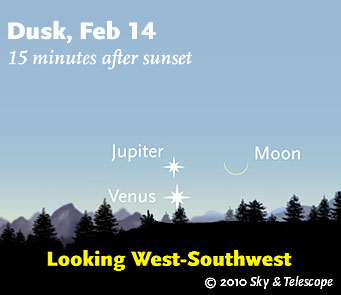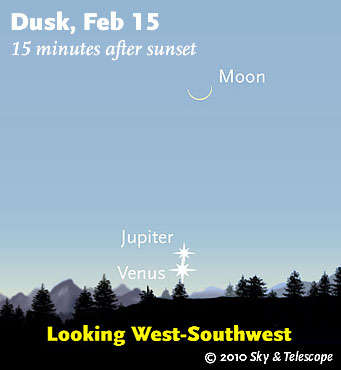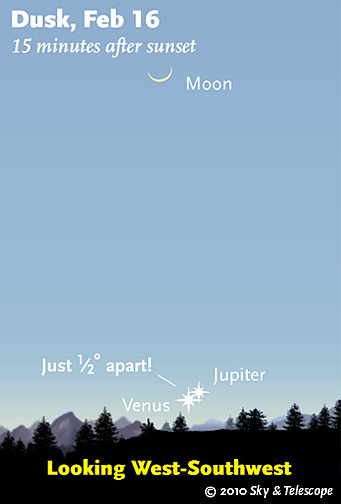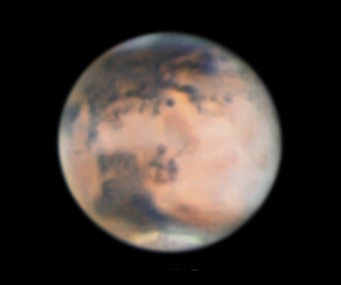Some daily events in the changing sky for February 12 – 20.
Friday, February 12

Sky & Telescope diagram
The asteroid 4 Vesta, in Leo, is an easy binocular target all month. This week it's at opposition and at its brightest, magnitude 6.1. Use the finder chart in the February Sky & Telescope, page 54, or online.
Before dawn Saturday morning (for the Americas), Vesta forms a "double star" with the 7th-magnitude star HD 89930. The pair changes orientation dramatically each hour as Vesta moves. They're within about 1 arcminute of each other when seen before dawn from North America.
Saturday, February 13
Sunday, February 14

Tony Flanders
Soon after sunset in very bright twilight, use binoculars to look for Venus, Jupiter, and the thin crescent moon barely above the west-southwest horizon, as illustrated above.
If you spot the Moon, does this set a young-crescent record for you? Seen from the East Coast of the U.S., the Moon is only about 20 hours after new. By the time it can be seen after sunset from the West Coast, the Moon is about 23 hours old. Compare the time you spot it (if you do!) with the time when the Moon was new (under "Saturday" above).
Monday, February 15
Tuesday, February 16

Venus and Jupiter reach conjunction, with the Moon now much more easily visible high above them. Bring binoculars.
Sky & Telescope diagram
Venus and Jupiter are in conjunction just ½° apart. Use binoculars to look for them very low about 15 minutes after sunset. The thickening crescent Moon high above them points the way, as shown at right.
Wednesday, February 17
Thursday, February 18
Friday, February 19
Saturday, February 20
Want to become a better amateur astronomer? Learn your way around the constellations. They're the key to locating everything fainter and deeper to hunt with binoculars or a telescope. For an easy-to-use constellation guide covering the whole evening sky, use the big monthly map in the center of each issue of Sky & Telescope, the essential magazine of astronomy. Or download our free Getting Started in Astronomy booklet (which only has bimonthly maps).
Once you get a telescope, to put it to good use you'll need a detailed, large-scale sky atlas (set of charts; the standards are Sky Atlas 2000.0 or the smaller Pocket Sky Atlas) and good deep-sky guidebooks (such as Sky Atlas 2000.0 Companion by Strong and Sinnott, the more detailed and descriptive Night Sky Observer's Guide by Kepple and Sanner, or the classic Burnham's Celestial Handbook). Read how to use them effectively.
More beginners' tips: "How to Start Right in Astronomy".
This Week's Planet Roundup
Mercury is disappearing deep into the glow of sunrise.
Venus and Jupiter are very deep in bright twilight after sunset, passing by each other as shown above. Jupiter is sinking day by day; Venus is slowly climbing up.

Dramatic things are happening on Mars's north polar cap (bottom) as it shrinks in the Martian springtime. Note the yellow dust storm on the cap's left side here, and the dulling of its right side compared to recent imagery in which it was bright white. At top are dark Mare Erythraeum, Margaritifer Sinus, Aurorae Sinus, and the Solis Lacus region. Lower left of center are dark Niliacus Lacus and Mare Acidalium. Note the many white clouds.
Veteran planetary imager Donald C. Parker of Coral Gables, Florida, took this superb image on the evening of February 2nd (at 4:00 Feb. 3 Universal Time), when the central meridian longitude was 62°. Click on the image for larger views and more information. South is up.
Parker used a 16-inch Newtonian reflector and a Skynyx 2-0 camera. Stacked-video imagery like this can show detail on a planet much more clearly than the eye can see through the same telescope.
Donald C. Parker
Mars, still fiery bright at magnitude –0.9, shines high in the east at dusk and is highest in the south around 10 or 11 p.m. It's in Cancer, below Pollux and Castor during evening.
In a telescope Mars is shrinking now: from 13.5 to 13.0 arcseconds wide this week. Its once-brilliant north polar cap has faded due to dust activity, as seen at right. Identify other surface features that you see using the Mars map and observing guide in the December Sky & Telescope, page 57.
Saturn (magnitude +0.7, in western Virgo) rises in the east around 8 or 9 p.m. and stands highest in the south around 1 or 2 a.m. In a telescope, Saturn's rings are tilted only 4.3° from edge-on to us, and they'll narrow further in the coming months.
Uranus and Neptune are behind the glare of the Sun.
Pluto is low in the southeast before dawn.
All descriptions that relate to your horizon or zenith — including the words up, down, right, and left — are written for the world's mid-northern latitudes. Descriptions that also depend on longitude (mainly Moon positions) are for North America. Eastern Standard Time (EST) equals Universal Time (also known as UT, UTC, or GMT) minus 5 hours.
To be sure to get the current Sky at a Glance, bookmark this URL:
http://SkyandTelescope.com/observing/ataglance?1=1
If pictures fail to load, refresh the page. If they still fail to load, change the 1 at the end of the URL to any other character and try again.
 0
0
Comments
You must be logged in to post a comment.